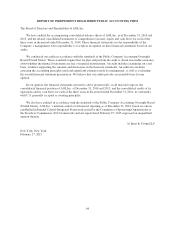America Online 2014 Annual Report Download - page 75
Download and view the complete annual report
Please find page 75 of the 2014 America Online annual report below. You can navigate through the pages in the report by either clicking on the pages listed below, or by using the keyword search tool below to find specific information within the annual report.AOL INC.
PART II—ITEM 7. MANAGEMENT’S DISCUSSION AND ANALYSIS OF FINANCIAL CONDITION
AND RESULTS OF OPERATIONS
future revenue streams and cash flows of the reporting unit. The discount rates utilized in the 2014 analyses
ranged from 9% to 22% and a constant terminal growth rate was used in the DCF analyses of 3.0%. Failure to
execute against our business plan for any of our reporting units could have a negative effect on the fair value of
such reporting unit, and increase the risk of a goodwill impairment in the future.
Income Taxes
Income taxes are presented in the accompanying consolidated financial statements using the asset and
liability method prescribed by the accounting guidance for income taxes. Income taxes (i.e., deferred tax assets,
deferred tax liabilities, taxes currently payable/refunds receivable and tax expense) are recorded based on
amounts refundable or payable in the current year and include the results of any difference between GAAP and
tax reporting. Deferred income taxes reflect expected future tax benefits (i.e., assets) and future tax costs (i.e.,
liabilities). The tax effect of net operating losses, capital losses and general business credit carryovers result in
deferred tax assets. The tax effect of temporary differences between the carrying amount of assets and liabilities
for financial statements and the basis amount for income tax purposes, as determined based upon currently-
enacted tax laws and rates, result in deferred tax assets and liabilities. Significant judgments are made in
computing our income tax provision and deferred income taxes.
Valuation allowances are established when management determines it is “more likely than not” that some
portion or the entire deferred tax asset may not be realized. We consider all positive and negative evidence in
evaluating our ability to realize our deferred income tax assets, including our operating results, ongoing tax
planning, and forecast of future taxable income, on a jurisdiction by jurisdiction basis. Significant judgment is
required with respect to the determination of whether or not a valuation allowance is required for certain of our
deferred tax assets.
We performed an analysis of the recoverability of our deferred tax assets as of December 31, 2014, which
took into consideration our historical operating results, as well as our projections of future operating results and
taxable income. Certain deferred tax assets related to capital losses, certain state net operating losses and other
state temporary differences, the majority of the foreign net operating losses and certain other foreign temporary
differences did not reach the “more likely than not” realizability criteria and accordingly, were subject to a
valuation allowance. We analyzed the remaining deferred tax assets using all positive and negative evidence to
determine whether we met the “more likely than not” criteria. We considered the fact that we have reported
cumulative income in the past three years in the relevant jurisdictions for which these deferred tax assets are
recorded, which generally provides positive evidence regarding realizability of deferred tax assets. Our
conclusion that such remaining deferred tax assets were “more likely than not” realizable also relied on the
weight of positive evidence related to projecting future taxable income based on management’s financial
projections and based on our historical results of operations. We currently expect positive growth in our
projected taxable income over our long-term planning horizon as we focus our resources on our core competitive
strengths in web content production, advertising and paid services while expanding the distribution of our
content, product and service offerings on multiple platforms and digital devices, including on portable wireless
devices such as smartphones and tablets. As a result of this analysis, we concluded that our deferred tax assets,
other than those for which a valuation allowance was recorded, continued to be more likely than not to be
realized. However, in the circumstance that the financial projections are not achieved, our ability to realize these
deferred tax assets may be significantly impacted.
From time to time, we engage in transactions in which the tax consequences may be subject to uncertainty.
Examples of such transactions include business acquisitions and dispositions, including dispositions designed to
be tax-free, issues related to consideration paid or received and certain financing transactions. Significant
59
























